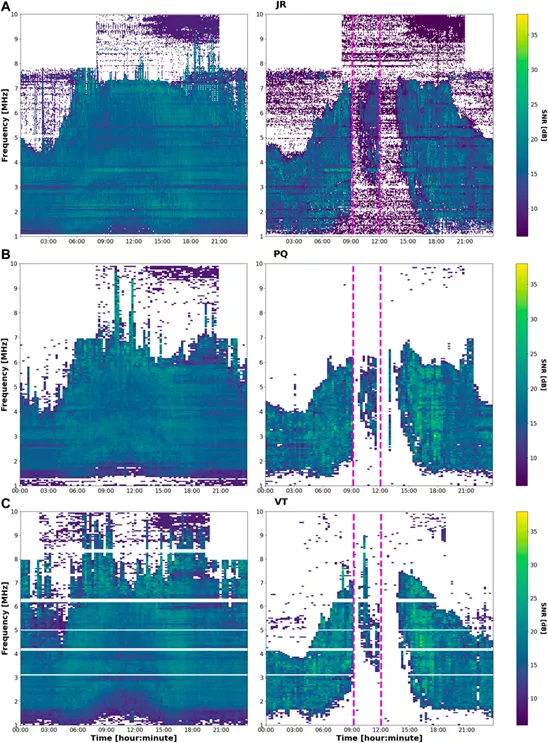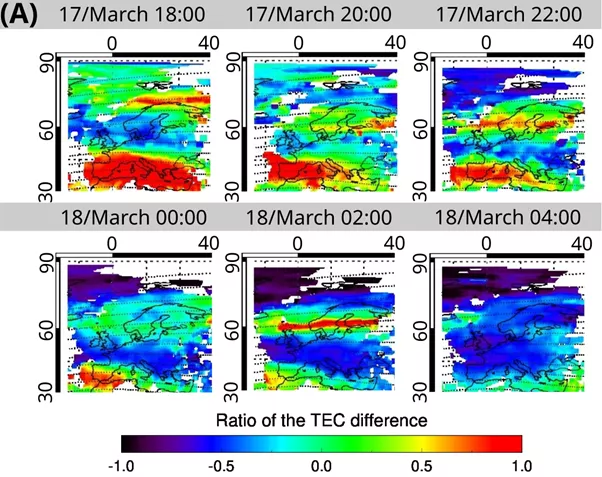Researchers at the ELKH Institute of Earth Physics and Space Science (EPSS) in Sopron collaborate with numerous international research groups to investigate the Earth's ionosphere, which is the partially ionized part of the atmosphere situated between 60 and 1000 km. The ionosphere is a complex and dynamic interface between the outer plasma space and the neutral atmosphere. Therefore, it can be influenced by effects from space above, mainly related to solar activity, as well as by processes below, connected to the intense changes in the neutral atmosphere, such as cold fronts and thunderstorms. Three recent papers on cosmically induced changes in the ionosphere in Central Europe have been published in a special issue titled 'Vertical Coupling in the Atmosphere-Ionosphere-Magnetosphere System' of the prestigious journal Frontiers in Astronomy and Space Sciences. The publication features new findings presented during the Workshop on Vertical Coupling in the Atmosphere-Ionosphere System, which was successfully held at EPSS last summer.
Fireball’s plasma trail observations
The first study investigated the ionospheric plasma properties of a meteor, more precisely, a fireball that burned spectacularly in Earth's atmosphere. Despite being a phenomenon known and studied by our ancestors, there are still numerous unanswered questions about cosmic bodies, commonly referred to as shooting stars or meteors, entering Earth's atmosphere. How does a meteor burn? How is it affected by local conditions? What is the range of properties of each meteor swarm? What kind of atmospheric chemistry is involved? The more opportunities the researchers have to investigate these and similar questions, the easier it becomes to find answers.
In 2018 and 2019, following an instrumental upgrade as part of the national GINOP project, a DPS-4D ionosonde was acquired by EPSS. Campaign-like minute-by-minute measurements were carried out during major meteor showers at the Széchenyi István Geophysical Observatory in Nagycenk. In order to separate meteor effects from other influences, synchronous measurements were conducted in Průhonice, Czech Republic (50.00°N, 14.60°E).
At 04:15 on 17 November 2019, the Průhonice station recorded an intriguing signal that, upon closer examination, turned out to have been left by a bright fireball (a cosmic body surpassing the brightness of Venus but dimmer than the Sun), thus creating the fifth opportunity in the history of science to study the so-called ionization effects of meteorites due to their metallicity and thermal effects, with minute-resolution data.

Figure 1. Optical detection of the trail left by the fireball at 04:15 am on 17 November 2019 (a). Snapshot of the plasma trace left by the meteor, which persisted for 20 minutes. The trace produced an extraordinary ionization, most likely exceeding the 17 MHz measurement limit (b).
Ionospheric effects of solar flares
In their second published study, the researchers at EPSS investigated the impact of so-called solar flares (high-energy 'explosions' occurring on the surface of the Sun, which can reach Earth and cause significant disruptions in radio communication and spacecraft operation) on the lower ionosphere (80–450 km), thus the electromagnetic waves propagating in the medium,, which also determines the quality of radio communication
A very intense period regarding solar activity (04–10 September 2017) was selected and the effect of 13 strong flares was investigated by comparing three different methods using the data of three European stations (Juliusruh, Germany; Průhonice, Czech Republic and San Vito, Italy).
Due to the extra ionization caused by solar flares, the absorption of electromagnetic waves in the lower ionosphere enhances, thus a larger part of the energy (and information) is absorbed, and the received signal will be much weaker, or even completely absorbed in a given frequency band in some cases. The current study provides an opportunity to compare the results obtained by different methods, to study the advantages and disadvantages of these methods and to choose the optimal method in a given case.
Throughout the research, the scientists observed a huge increase in intensity up to 1400% compared to the quiet period. However, the obtained values were greatly influenced primarily by factors such as the used test method, the intensity of the flare, and the time of day when the impact of the flare reached Earth.

Figure 2. Illustration of the results obtained by one of the methods used in the study, the so-called signal-to-noise ratio (SNR) method based on data derived from an average calm day (left-hand column) and from one day of the test period (06 September 2017; right-hand column), when the effect of two very strong X-class flares (indicated by dashed vertical lines in the figures) was also detectable. JR: Juliusruh, PQ: Průhonice, VT: San Vito stations.
Ionospheric changes caused by geomagnetic storms
In their third study, the researchers demonstrated how the F-layer (250-400 km) of the ionosphere over Europe responded to the two largest geomagnetic storms of the 24th solar cycle. Within Earth's plasma environment (ionosphere, plasmasphere, and outer magnetosphere), all regions are closely coupled. The F-layer of the ionosphere has the highest electron density, so electron density changes are most pronounced here. Solar flares, accompanied by Coronal Mass Ejections (CMEs) reaching Earth's environment, can cause substantial changes in the geomagnetic field, so called geomagnetic storms, which manifest themselves in the ionosphere as ionospheric storms.
Previous studies have distinguished two different phases of ionospheric storms: a positive phase, when the electron density increases, and a negative phase, when the electron density decreases compared to the expected value.
For this study, data from 5 European digisonde stations (ionospheric electron density monitors), total electron content (GNSS TEC) measured by the Global Navigation Satellite System (GNSS), and Swarm satellite data were utilized to study the selected events (11-17 November 2012 and 16-25 March 2015). The study focused on the main phase of geomagnetic storms, when a very decreased plasma density in the F-layer was observed during the night hours compared to calm days.
The results suggest that the extreme depletion observed in F-layer electron density and total electron content data, relative to reference days, was directly related to the equatorward movement of the midlatitude ionospheric trough (which is generally the reduced electron content region in the auroral zone). Previous studies have found that the minimum location of the nighttime ionospheric trough coincides with the ionospheric footprint of the plasmaspheric boundary ("plasmapause"), so in the present data researchers could also observe the movement of the plasmapause during the geomagnetic storm.
In this study, the researchers have developed a new method that allows the tracking of the storm-time evolution and the movement of different ionospheric disturbances in the thermosphere-ionosphere-plasmasphere system by a combined analysis of global digisonde network data, total electron content data relative to reference days, and satellite data.

Figure 3. Variation of total electron content with respect to calm days during the night-time hours of the geomagnetic storms over Europe. Red indicates an increase in electron density, blue a decrease. The blue band moving towards the equator actually shows the motion of the ionospheric trough.
Publications:
The special issue:
https://www.frontiersin.org/research-topics/43500/vertical-coupling-in-the-atmosphere-ionosphere-magnetosphere-system
https://www.frontiersin.org/articles/10.3389/fspas.2023.1197832/full
https://www.frontiersin.org/articles/10.3389/fspas.2023.1201625/full
https://www.frontiersin.org/articles/10.3389/fspas.2023.1092850/full